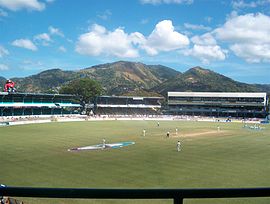| The Oval | |||||
 | |||||
| Ground information | |||||
|---|---|---|---|---|---|
| Location | Port of Spain, Trinidad and Tobago | ||||
| Establishment | 1896 | ||||
| Capacity | 20,000 | ||||
| Owner | Queen's Park Cricket Club | ||||
| End names | |||||
| Brian Lara Pavilion End Media Centre End | |||||
| International information | |||||
| First Test | 1–6 February 1930: | ||||
| Last Test | 7–11 August 2024: | ||||
| First ODI | 9 March 1983: | ||||
| Last ODI | 27 July 2022: | ||||
| First T20I | 15 March 2009: | ||||
| Last T20I | 2 April 2017: | ||||
| First WODI | 18 March 2003: | ||||
| Last WODI | 3 November 2013: | ||||
| First WT20I | 6 May 2012: | ||||
| Last WT20I | 9 May 2012: | ||||
| Team information | |||||
| |||||
| As of 7 August 2024 Source: Cricinfo | |||||
The Queen's Park Oval is a sports stadium in Port of Spain, Trinidad and Tobago, used mostly for cricket matches. It opened in 1896. Privately owned by the Queen's Park Cricket Club, it is currently the second largest capacity cricket ground in the West Indies with seating for about 20,000 spectators.[1]
It has hosted more Test matches than any other ground in the Caribbean with 60 as of January 2018, and has also hosted a number of One-Day International (ODI) matches, including many World Series Cricket games in 1979, and matches of the 2007 Cricket World Cup. The Trinidad and Tobago cricket team play most of their home matches at the ground,[2] and it is the home ground of the Caribbean Premier League team Trinbago Knight Riders.
Considered by many players, journalists and critics as one of the most picturesque cricket venues,[2][3][4][5] the ground first hosted a Test match in February 1930 when England toured the Caribbean, though it had previously hosted many first class tours as early as the 1897 tour under Lord Hawke.[2] The pavilion dates back to 1896, though there were extensive renovations in the 1950s and in 2007, prior to the World Cup and following an earthquake.[6][7] The "Concrete Stand" was renamed the "Learie Constantine Stand" in recognition of that former West Indies cricketer. The first ODI match at the ground was in March 1983, and the first Twenty20 International in 2009.[2]
As well as the main cricket stadium, the facility includes a gym, indoor and outdoor cricket practice nets, two squash courts and two outdoor tennis courts. The cricket field has also been used to host several domestic and international football matches, and several music events.
- ^ "Bonus $$ for Steel". The Trinidad Guardian Newspaper. Archived from the original on 2015-07-31. Retrieved 2015-07-28.
- ^ a b c d "Queen's Park Oval". ESPN CricInfo. Archived from the original on 28 October 2013. Retrieved 16 December 2013.
- ^ Boycott, Geoff (2006). Boycott: The Autobiography. Pan Macmillan. p. 81. ISBN 0330447378.
- ^ Berry, Scyld (December 4, 2012). "Queen's Park Oval — Scyld Berry's top five Test cricket grounds". The Daily Telegraph. Archived from the original on 8 March 2014. Retrieved 15 January 2014.
- ^ Beckles, Stoddart (1999), p. 141.
- ^ "Queen's Park Oval pavilion unveiled". ESPN CricInfo. February 8, 2007. Archived from the original on 7 October 2013. Retrieved 16 December 2013.
- ^ "Earthquake shakes Antigua and Trinidad". ESPN CricInfo. February 27, 2007. Archived from the original on 7 October 2013. Retrieved 16 December 2013.